Abstract
The bacterial epiphyte Pseudomonas syringae MF714R was cultured on agar or in broth or collected from colonized leaves; it was then inoculated onto greenhouse-grown bean plants incubated in a growth chamber at low relative humidity or in the field or onto field-grown bean plants. Cells cultured in liquid medium survived the least well after inoculation of leaf surfaces under all conditions. Cells cultured in solid medium exhibited the highest percent survival and desiccation tolerance in the growth chamber but generally survived less well in the field than did cells harvested from plants. Cells harvested from plants and inoculated onto plants in the field usually exhibited the highest percent survival, started to increase in population earlier, and reached a higher number than did cells cultured in vitro. Differences in field survival were apparently not attributable to differential UV tolerance. The observed effects of phenotypic plasticity on epiphytic survival and colonization should be considered in risk assessment studies, in studies of bacterial epidemiology, and in the use of microbial antagonists for biological pest control.
Full text
PDF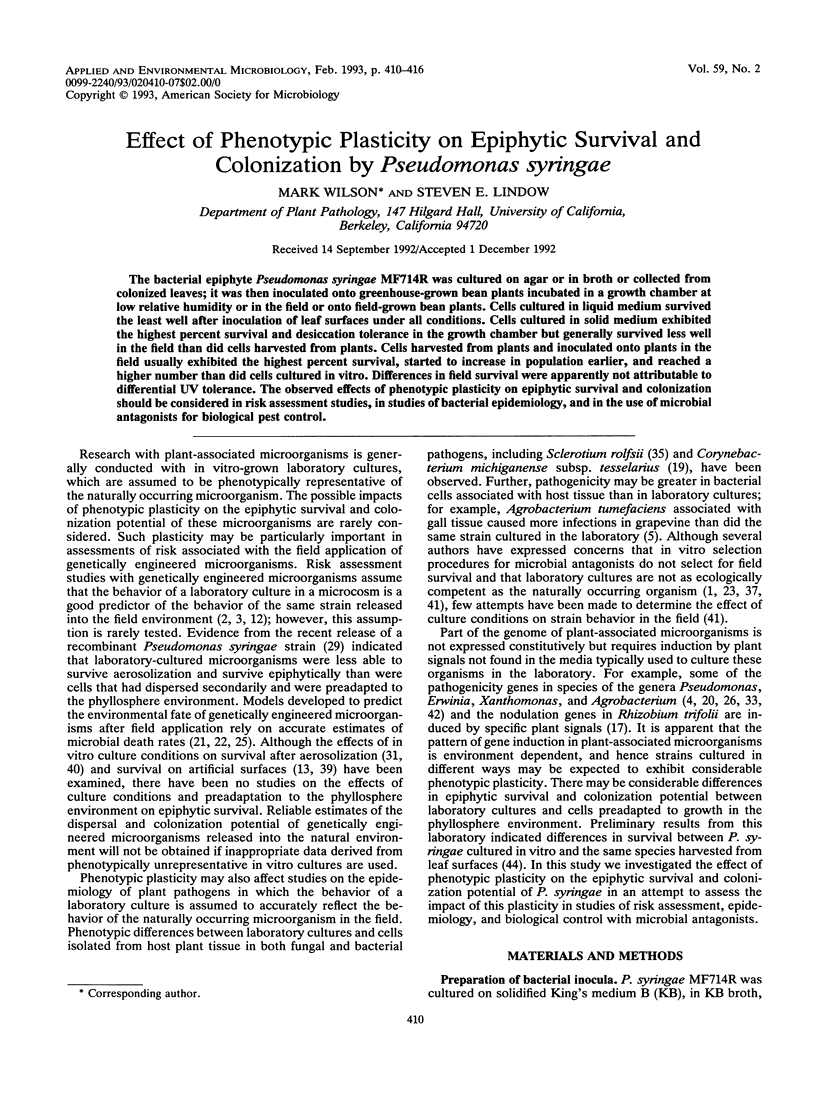
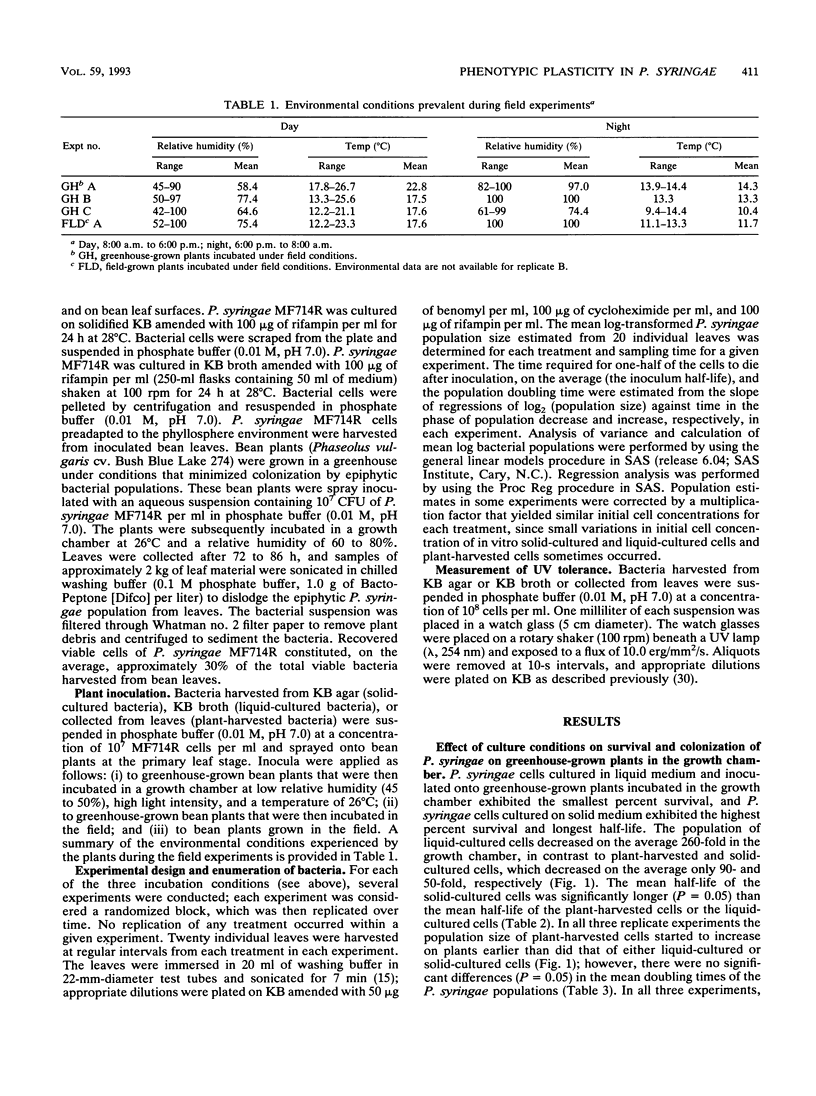
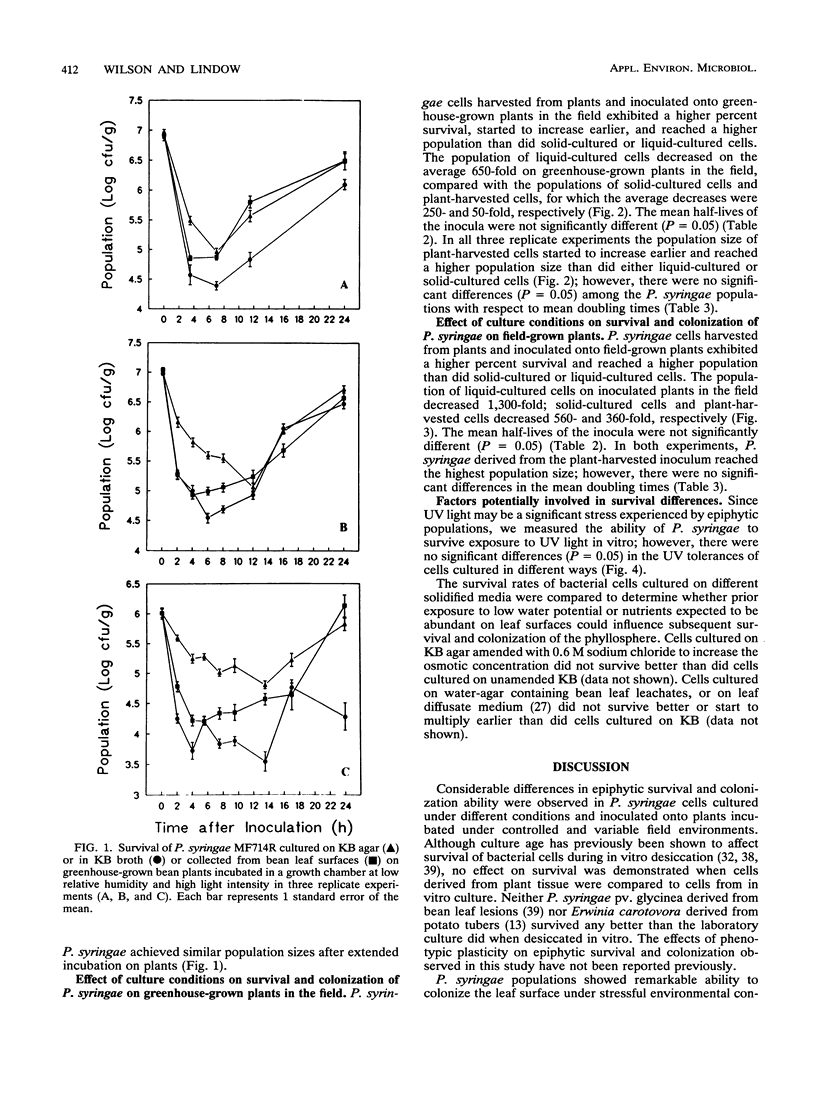
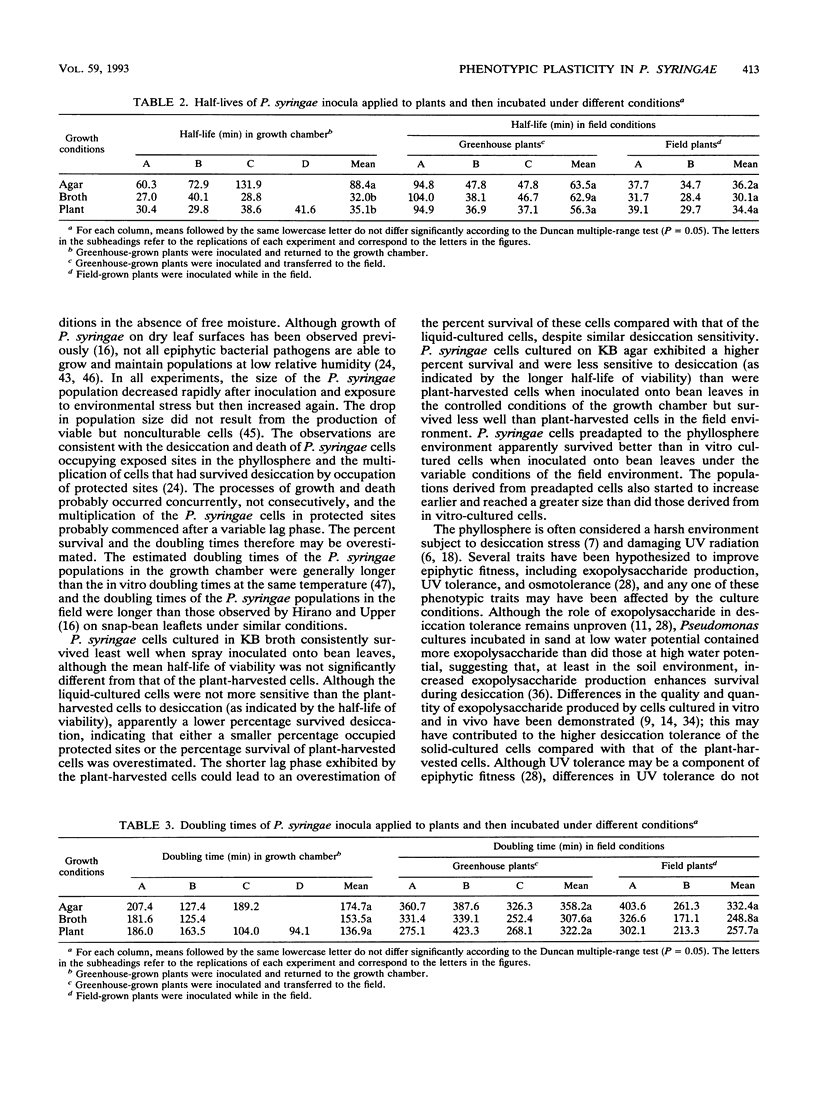
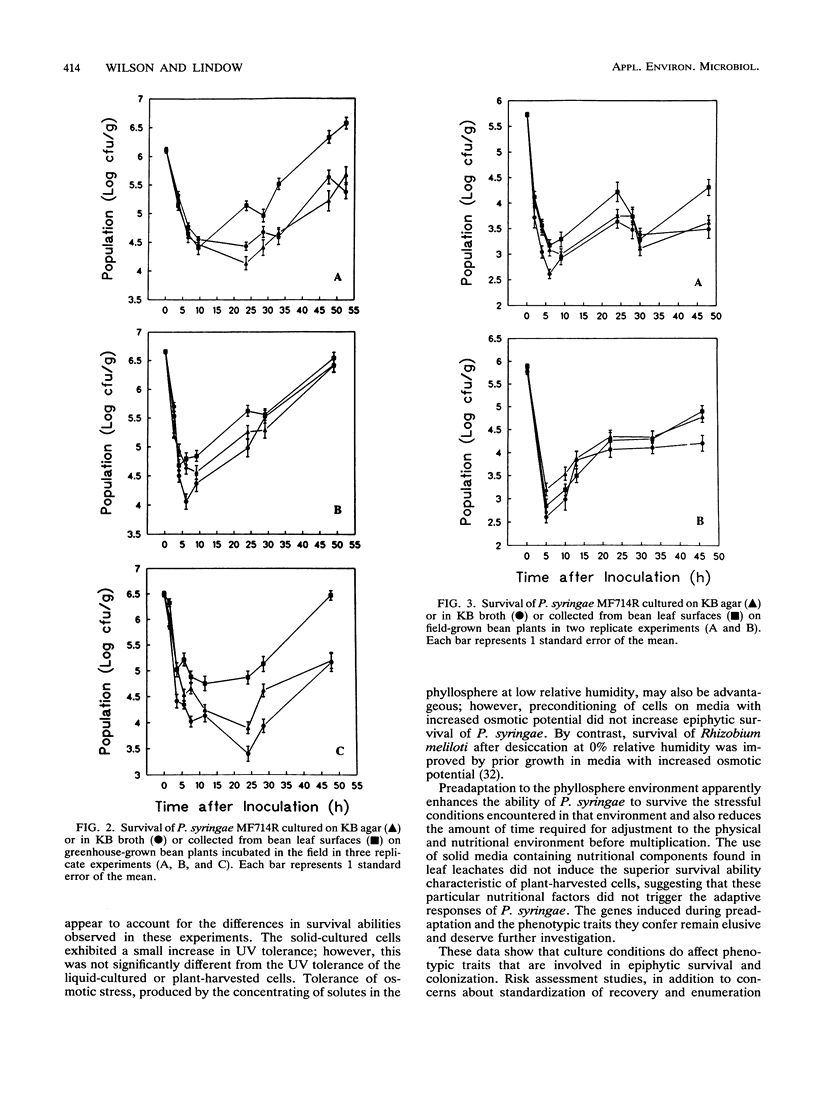
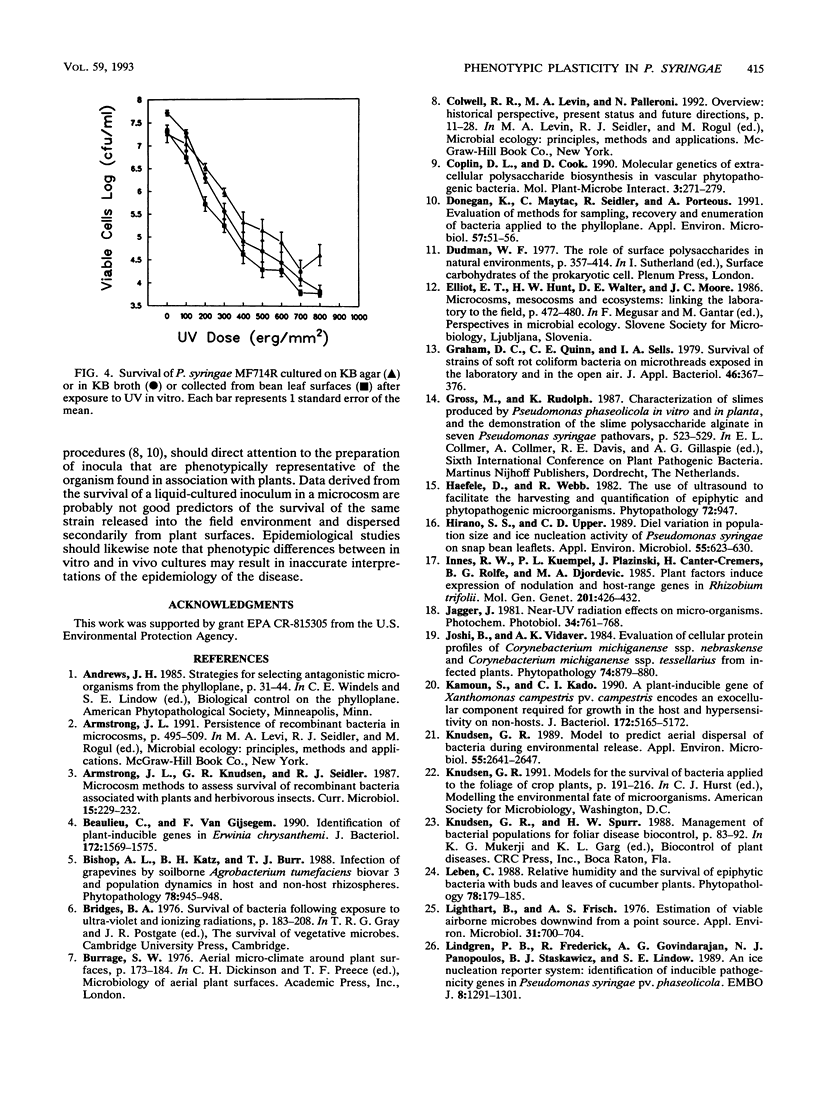
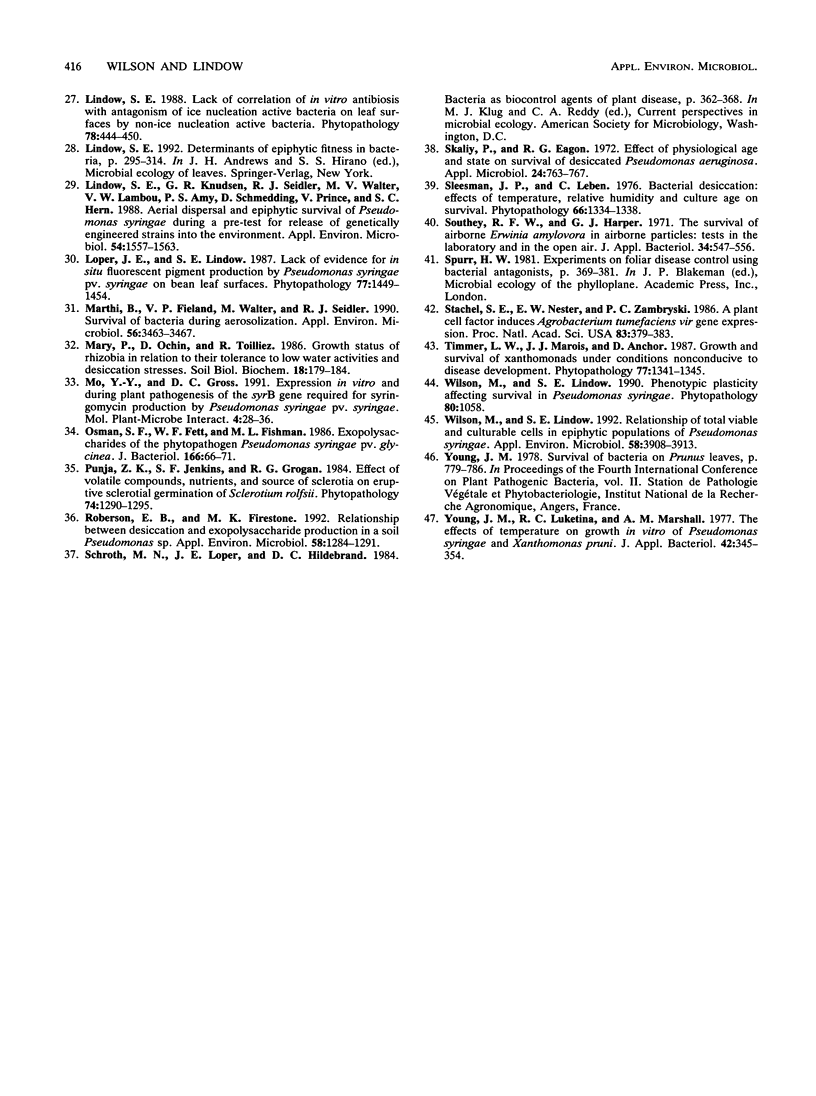
Selected References
These references are in PubMed. This may not be the complete list of references from this article.
- Beaulieu C., Van Gijsegem F. Identification of plant-inducible genes in Erwinia chrysanthemi 3937. J Bacteriol. 1990 Mar;172(3):1569–1575. doi: 10.1128/jb.172.3.1569-1575.1990. [DOI] [PMC free article] [PubMed] [Google Scholar]
- Coplin D. L., Cook D. Molecular genetics of extracellular polysaccharide biosynthesis in vascular phytopathogenic bacteria. Mol Plant Microbe Interact. 1990 Sep-Oct;3(5):271–279. doi: 10.1094/mpmi-3-271. [DOI] [PubMed] [Google Scholar]
- Donegan K., Matyac C., Seidler R., Porteous A. Evaluation of methods for sampling, recovery, and enumeration of bacteria applied to the phylloplane. Appl Environ Microbiol. 1991 Jan;57(1):51–56. doi: 10.1128/aem.57.1.51-56.1991. [DOI] [PMC free article] [PubMed] [Google Scholar]
- Hirano S. S., Upper C. D. Diel Variation in Population Size and Ice Nucleation Activity of Pseudomonas syringae on Snap Bean Leaflets. Appl Environ Microbiol. 1989 Mar;55(3):623–630. doi: 10.1128/aem.55.3.623-630.1989. [DOI] [PMC free article] [PubMed] [Google Scholar]
- Jagger J. Near-UV radiation effects on microorganisms. Photochem Photobiol. 1981 Dec;34(6):761–768. [PubMed] [Google Scholar]
- Kamoun S., Kado C. I. A plant-inducible gene of Xanthomonas campestris pv. campestris encodes an exocellular component required for growth in the host and hypersensitivity on nonhosts. J Bacteriol. 1990 Sep;172(9):5165–5172. doi: 10.1128/jb.172.9.5165-5172.1990. [DOI] [PMC free article] [PubMed] [Google Scholar]
- Knudsen G. R. Model to predict aerial dispersal of bacteria during environmental release. Appl Environ Microbiol. 1989 Oct;55(10):2641–2647. doi: 10.1128/aem.55.10.2641-2647.1989. [DOI] [PMC free article] [PubMed] [Google Scholar]
- Lighthart B., Frisch A. S. Estimation of viable airborne microbes downwind from a point source. Appl Environ Microbiol. 1976 May;31(5):700–704. doi: 10.1128/aem.31.5.700-704.1976. [DOI] [PMC free article] [PubMed] [Google Scholar]
- Lindgren P. B., Frederick R., Govindarajan A. G., Panopoulos N. J., Staskawicz B. J., Lindow S. E. An ice nucleation reporter gene system: identification of inducible pathogenicity genes in Pseudomonas syringae pv. phaseolicola. EMBO J. 1989 May;8(5):1291–1301. doi: 10.1002/j.1460-2075.1989.tb03508.x. [DOI] [PMC free article] [PubMed] [Google Scholar]
- Lindow S. E., Knudsen G. R., Seidler R. J., Walter M. V., Lambou V. W., Amy P. S., Schmedding D., Prince V., Hern S. Aerial Dispersal and Epiphytic Survival of Pseudomonas syringae during a Pretest for the Release of Genetically Engineered Strains into the Environment. Appl Environ Microbiol. 1988 Jun;54(6):1557–1563. doi: 10.1128/aem.54.6.1557-1563.1988. [DOI] [PMC free article] [PubMed] [Google Scholar]
- Marthi B., Fieland V. P., Walter M., Seidler R. J. Survival of bacteria during aerosolization. Appl Environ Microbiol. 1990 Nov;56(11):3463–3467. doi: 10.1128/aem.56.11.3463-3467.1990. [DOI] [PMC free article] [PubMed] [Google Scholar]
- Osman S. F., Fett W. F., Fishman M. L. Exopolysaccharides of the phytopathogen Pseudomonas syringae pv. glycinea. J Bacteriol. 1986 Apr;166(1):66–71. doi: 10.1128/jb.166.1.66-71.1986. [DOI] [PMC free article] [PubMed] [Google Scholar]
- Roberson E. B., Firestone M. K. Relationship between Desiccation and Exopolysaccharide Production in a Soil Pseudomonas sp. Appl Environ Microbiol. 1992 Apr;58(4):1284–1291. doi: 10.1128/aem.58.4.1284-1291.1992. [DOI] [PMC free article] [PubMed] [Google Scholar]
- Skaliy P., Eagon R. G. Effect of physiological age and state on survival of desiccated Pseudomonas aeruginosa. Appl Microbiol. 1972 Nov;24(5):763–767. doi: 10.1128/am.24.5.763-767.1972. [DOI] [PMC free article] [PubMed] [Google Scholar]
- Stachel S. E., Nester E. W., Zambryski P. C. A plant cell factor induces Agrobacterium tumefaciens vir gene expression. Proc Natl Acad Sci U S A. 1986 Jan;83(2):379–383. doi: 10.1073/pnas.83.2.379. [DOI] [PMC free article] [PubMed] [Google Scholar]
- Wilson M., Lindow S. E. Relationship of total viable and culturable cells in epiphytic populations of Pseudomonas syringae. Appl Environ Microbiol. 1992 Dec;58(12):3908–3913. doi: 10.1128/aem.58.12.3908-3913.1992. [DOI] [PMC free article] [PubMed] [Google Scholar]
- Young J. M., Luketina R. C., Marshall A. M. The effects on temperature on growth in vitro of Pseudomonas syringae and and Xanthomonas pruni. J Appl Bacteriol. 1977 Jun;42(3):345–354. doi: 10.1111/j.1365-2672.1977.tb00702.x. [DOI] [PubMed] [Google Scholar]


